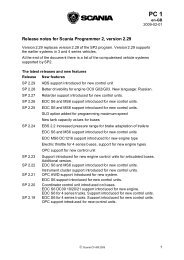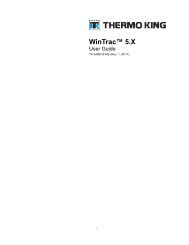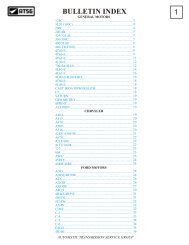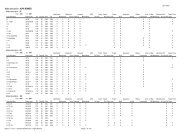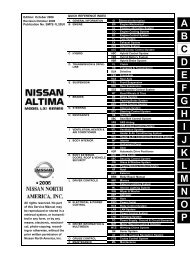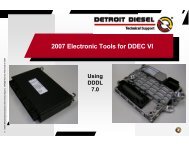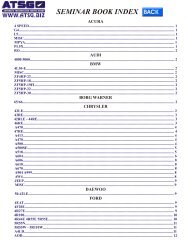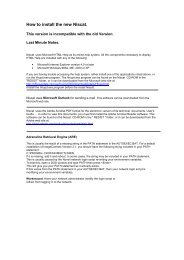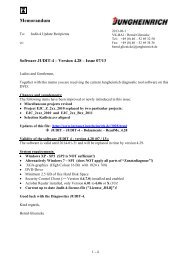VCP User Guide PDF
VCP User Guide PDF
VCP User Guide PDF
- No tags were found...
Create successful ePaper yourself
Turn your PDF publications into a flip-book with our unique Google optimized e-Paper software.
VEHICLE ELECTRONICS PROGRAMMINGSTATION<strong>VCP</strong> <strong>User</strong>’s <strong>Guide</strong>VEPS 7.52
Cummins Vendor Component Program (<strong>VCP</strong>) for Win32 SystemsAdditions and Changes in the <strong>VCP</strong>• Cummins <strong>VCP</strong> Addition (7.5.x)Added remaining support for the Heavy Duty (ISM/ISX) 2007 platform and MidRange (ISB and ISC/ISL) 2007 platform. PAR files will use S,MODULE,EAGLE orS,MODULE,ISB07 or S,MODULE,ISC07 for these ECMs. All three of these optionscan be used for ANY of the 2007 platforms.• Cummins <strong>VCP</strong> Addition (7.4)Added remaining support for the Heavy Duty (ISM/ISX) 2007 platform. PAR fileswill use S,MODULE,EAGLE for these ECMs.• Cummins <strong>VCP</strong> Addition (7.3.3)If a Write Verification Error occurs, attempt to write the parameter again beforereporting the error.• Cummins <strong>VCP</strong> Addition (7.3)Added support for the Heavy Duty (ISM/ISX) 2007 platform. PAR files will useS,MODULE,EAGLE for these ECMs. This release contains a subset of all 2007parameters. The rest of the parameters will be supported in the next release.• Cummins <strong>VCP</strong> Addition (7.2)Added support for the European Level 4 Emissions application.• Cummins <strong>VCP</strong> configuration (7.1)A problem with the Cummins <strong>VCP</strong> control panel applet has been fixed. PCs that hadmore the five drivers listed in their RP121032.INI file could not run the Cummins<strong>VCP</strong> control panel applet.• Base Communications Addition (7.0)A new ECM to tool interface has been implemented (GTIS 4.5). Additional featuresof the common components library (MDAS CC) are used to communicate with GTIS4.5 compliant ECMs. All remaining references to the DCL have been removed.• <strong>VCP</strong> Configuration and Administration Rights (7.0)Previously, if a user without administration rights used VEPS, the default settings for<strong>VCP</strong> configuration were always used, instead of the <strong>VCP</strong> Configuration settingsprogrammed by the administrator. Now, if the administrator changes the <strong>VCP</strong>Configuration from the default settings, users without administration rights will seethese changes.• Trace / Debug (6.61)The MDAS CC now supports the use of Trace / Debug to aid in debugging should aproblem arise.- 2 - 12/15/06
Cummins Vendor Component Program (<strong>VCP</strong>) for Win32 Systems• Base Communications Change (6.60)The existing low level communications component (DCL) was replaced by anupdated communications library (MDAS CC). This change was implemented to allowsupport for future engine programs.- 3 - 12/15/06
Cummins Vendor Component Program (<strong>VCP</strong>) for Win32 Systems1 OVERVIEW ................................................................................................................52 VEPS WIRING CONNECTIONS.............................................................................63 PARAMETER FILE...................................................................................................6SETUP RECORDS...............................................................................................................6PARAMETER RECORDS ....................................................................................................7REMARK RECORDS ..........................................................................................................74 COMMAND LINE......................................................................................................95 USER INTERFACE..................................................................................................10LED’S.............................................................................................................................10Blinking Yellow ...........................................................................................................10Blinking Green ............................................................................................................10Solid Green..................................................................................................................10Solid Yellow.................................................................................................................10Solid Red .....................................................................................................................10LIST BOX ........................................................................................................................11BUTTONS.........................................................................................................................14Information Button ......................................................................................................14Report Button ..............................................................................................................15Exit Button...................................................................................................................156 CONFIGURATION UTILITY ................................................................................16<strong>VCP</strong> STATUS WINDOW ..................................................................................................16<strong>VCP</strong> Status Window - Show ........................................................................................16<strong>VCP</strong> Status Window- Automatically Terminate ..........................................................17<strong>VCP</strong> Status Window - Display time.............................................................................17COMMUNICATIONS.........................................................................................................17Inline II – J1939 ..........................................................................................................17RP1210........................................................................................................................17REPORTS.........................................................................................................................17MISCELLANEOUS SETTINGS ...........................................................................................17Erase inactive faults....................................................................................................17Show parameter description in verification file..........................................................18Give warnings for parameter dependencies ...............................................................18Write engine information to verification file...............................................................19Enable Write Verification ...........................................................................................19Invocation Information in Verification File................................................................19Writer Trace / Debug Information ..............................................................................19- 4 - 12/15/06
Cummins Vendor Component Program (<strong>VCP</strong>) for Win32 Systems1 OverviewThe Cummins <strong>VCP</strong> is an Engine programming tool designed to help OEM’s programengine on the assembly line. It is designed in accordance with standards for VehicleElectronics Programming Stations (VEPS) outlined in SAE J2461 and supports theassociated J2286 compliant parameter and verification files.The basic operation of any VEPS <strong>VCP</strong> is to program an ECM according a parameter file,and pass status information back to the calling program in a verification file. The namesof the parameter and verification files are passed via the command line. This is shown inFigure 1.ParameterFileOEM Shop FloorProgramCommand LineCummins <strong>VCP</strong>VerificationFileFigure 1 - VEPS Operation- 5 - 12/15/06
Cummins Vendor Component Program (<strong>VCP</strong>) for Win32 Systems2 VEPS Wiring ConnectionsOEM programming of a Cummins engine over J1587 or J1939 datalinks can beaccomplished either prior to or after the engine is installed the vehicle chassis.Programming the engine after it is installed in the chassis is recommended; however, ifthis is not possible and the engine must be programmed prior to installation in thechassis, additional precautions need to be taken to limit the potential damage to theEngine Control Module (ECM).• When connecting VEPS to the vehicle or ECM datalink, the datalink adaptorpower supply must have a common ground connection with the Battery (-)connection of the ECM. The datalink adaptor should be powered from the samepower supply as the ECM. If this is not possible and the datalink adaptor has aseparate power supply, the supply must have a common ground connection withthe Battery (-) connection of the ECM.• The ECM power connection must be made prior to energizing the ECM (Do not"Hot Plug" the ECM).• The ECM Battery (-) must be connected to the engine block prior to energizingthe key switch line.• The key switch line must be de-energized prior to de-energizing the ECM.• ECM must be de-energized prior to disconnecting the power and groundconnections.3 Parameter FileThe parameter file is the primary interface to the Cummins <strong>VCP</strong>. It is a text filecontaining a list of parameters and values to be programmed in the ECM. The Cummins<strong>VCP</strong> supports three SAEJ2286 record formats.• Setup Records• Parameter Records, and• Remarks RecordsSetup RecordsTwo setup records are required for VEPS to program an engine ECM.• Communications Port, and• Engine Module TypeThe communications port setup record is used to identify the port to which the datalinkadapter is connected. Here is an example that specifies COMM 1 as the port:S,COMX,1- 6 - 12/15/06
Cummins Vendor Component Program (<strong>VCP</strong>) for Win32 SystemsThe engine module type setup record is used to specify the target ECM family for a givenparameter file. That is, this record limits the type of ECMs VEPS will program with agiven parameter file. This is to prevent a parameter file intended for say an ISB to beloaded into an N14. Here is the format of the module type setup record:S, MODULE, Module Names are as follows:HDD or 98HDD for ISM, ISX, & Signature 600,NCORE for ISB, ISC, & ISL,Celect+ for N14 & M11,ECHO for ISBe,CGAS for C8.3G Plus, L10 Plus & B5.9G Plus,DE for ISX 02, ISM 02, & ISM 04,ECHO2 for ISB 02, ISC 03 & ISL 03,TIER3C2 for QSB 07, QSC 04 and QSL 04EAGLE for ISM 07 and ISX 07ISB07 (or EAGLE) for ISB 07ISC07 (or EAGLE) for ISC 07 or ISL 07Parameter RecordsParameter Records indicated which parameters and values to program in the ECM. Theparameter file may contain any number of parameter records, in any order. The formatfor parameter records must be as follows:P,,,,The VEPS names for each parameter are defined in the OEM reference manuals for eachengine. The command field may take on the value of R (read), W (write), or B (both)although specifying B has the same effect as specifying W. Values must be numeric fortrims, Y or N for features, and ASCII for Dataplate.Remark RecordsRemark records are used to place comments in the parameter file, and are ignored by theapplication. The format of a remark record is shown below:REM An example of a parameter file for a HDD module is shown below.S,COMX,1S,MODULE,HDD- 7 - 12/15/06
Cummins Vendor Component Program (<strong>VCP</strong>) for Win32 SystemsP,10000,W,100P,20011,W,YP,21781,W,YP,12280,W,4599P,12310,W,4000P,12860,W,3000P,12870,W,2000P,12479,W,YREM P,10300,W,2REM P,11340,W,5- 8 - 12/15/06
Cummins Vendor Component Program (<strong>VCP</strong>) for Win32 Systems4 Command LineVEPS parameter and verification files must be passed as command line arguments to the<strong>VCP</strong>. The <strong>VCP</strong> will also generate a report file and documentation file if specified on thecommand lineParameter File-p Use this command line option to specify the name of the parameter file to be loaded intothe Engine ECM. If the –p option is omitted, the <strong>VCP</strong> will look for a file namedceco600.par in the install directory to load into the ECM.Verification File-v Use this command line option to specify the name of the verification file to receive theresults of the programming session. If the –v option is omitted, the <strong>VCP</strong> will create a filenamed ceco600.ver in the install directory.Report File-r Use this option to save a comma delimited version of the VEPS Session report in thespecified file. This option is provided as a means to save session reports since the <strong>VCP</strong>will not save or redisplay previously generated session reports. Report files can beviewed later by importing them into most spreadsheets.OEM Key-i Use this option to place a unique identifier in the header of the session report. Thisoption is provided as a means to associate a report with a specific vehicle. Typically thereport identifier is a VIN or customer order number, but it may also be a model number,or other identifying string..Documentation File-dUse this option by itself to generate a comma delimited version of OEM documentation.This option places a file called OEMDoc.csv in the Documents subdirectory of the installdirectory. Once this file is created, the user may open the OEM Documentation.doc fileand run a macro that will build a complete set of parameter documentation for thatspecific ECM.The following example illustrates the use of the command line parameters:- 9 - 12/15/06
Cummins Vendor Component Program (<strong>VCP</strong>) for Win32 Systemsceco600.exe -p c:\<strong>VCP</strong>\Cummins\abc.par -v c:\<strong>VCP</strong>\Cummins\abc.ver –r c:\<strong>VCP</strong>\Cummins\abc.vrp –i 123456In the previous example, the <strong>VCP</strong> (ceco600.exe) will look for the parameter file (abc.par)in the directory c:\<strong>VCP</strong>\Cummins. The <strong>VCP</strong> will write the verification file (abc.ver) inthe directory c:\<strong>VCP</strong>\Cummins. The <strong>VCP</strong> will write the report file (abc.vrp) in thedirectory c:\<strong>VCP</strong>\Cummins. The OEM key “123456” will be printed in header of theVEPS session report.5 <strong>User</strong> InterfaceLED’sLED’s are used to give a visual status of the programming session. There are 5 ways inwhich the LED’s provide status information.Blinking YellowThe <strong>VCP</strong> is attempting to initialize communication with the Engine.Blinking GreenThe <strong>VCP</strong> has established communication with the ECM and is programming thespecified parameters.Solid GreenSuccessful VEPS session. There are no parameter errors.Solid YellowA parameter error has occurred. The VEPS session was successful, but at leastone parameter has an error. If the user clicks on the parameter error icon, then amessage box will appear with a detailed description of the error, as shown inFigure 5Solid RedA fatal error has occurred. The <strong>VCP</strong> has terminated communications with theECM. The cause of the error is displayed in the list box.- 10 - 12/15/06
Cummins Vendor Component Program (<strong>VCP</strong>) for Win32 SystemsList BoxDuring the <strong>VCP</strong> session, runtime status messages are displayed in the list box on themain window. These status messages are used primarily inform the user of status and fortrouble shooting.Figure 2 – <strong>VCP</strong> Status- 11 - 12/15/06
Cummins Vendor Component Program (<strong>VCP</strong>) for Win32 SystemsOnce the <strong>VCP</strong> has finished programming the ECM, the List Box displays theprogrammed parameters as shown in Figure 3.Figure 3 – End of SessionIf an error occurred on one of the programmed parameters, the list box displays a yellowexclamation icon next to the parameter(s) which encountered the error (See Figure 4).All parameter errors will be shown in the list box first.If the parameter had an error, the user may double click on the icon or VEPS Name of theparameter to display a detail error message. This is shown in Figure 5- 12 - 12/15/06
Cummins Vendor Component Program (<strong>VCP</strong>) for Win32 SystemsFigure 4 – Parameter ErrorFigure 5 - Error Message Displayed- 13 - 12/15/06
Cummins Vendor Component Program (<strong>VCP</strong>) for Win32 SystemsButtonsThere are three Buttons on the main window; Information Button, Report Button, andExit Button. These buttons are disabled until the VEPS session is completed.Information ButtonPressing the Information Button will display advanced information about the ECM, ECMCalibration, and <strong>VCP</strong> Software. This information is often valuable when troubleshooting the application.Figure 6 - Information Dialog- 14 - 12/15/06
Cummins Vendor Component Program (<strong>VCP</strong>) for Win32 SystemsReport ButtonPressing the report button will display the VEPS session report in a “print preview “stylewindow. The report may be printed from this screen, or the user may simply exit to themain window.Exit ButtonThis button exits the <strong>VCP</strong>.Figure 7 – VEPS Session Report- 15 - 12/15/06
Cummins Vendor Component Program (<strong>VCP</strong>) for Win32 Systems6 Configuration UtilityA configuration utility program is included with the Cummins <strong>VCP</strong> distribution. Thisutility allows the user to modify some aspects of <strong>VCP</strong> operation. The configurationutility may be accessed via the control panel.Figure 8 - <strong>VCP</strong> Configuration Utility<strong>VCP</strong> Status WindowThe <strong>User</strong> Interface can be given various behaviors based on the calling environment, andhow the <strong>VCP</strong> is integrated in with the OEM’s VEPS system.<strong>VCP</strong> Status Window - ShowThis check box determines if the <strong>VCP</strong> user interface is to be displayed. If the userdoes not want the user interface to be displayed during programming, then thisbox should be unchecked.- 16 - 12/15/06
Cummins Vendor Component Program (<strong>VCP</strong>) for Win32 Systems<strong>VCP</strong> Status Window- Automatically TerminateThis checkbox should be checked if the user desires that the user interfaceautomatically terminate at the end of the VEPS session, instead of waiting for theuser to press the Exit button. This option may be used to return control to thecalling program without any additional user interaction<strong>VCP</strong> Status Window - Display timeThis value is only valid when the user has configured the <strong>VCP</strong> to automaticallyterminate. This value is the amount of time, in seconds, that the user interfacewill stay active after the <strong>VCP</strong> session has ended.CommunicationsInline II – J1939When specifying the Inline II, the <strong>VCP</strong> will try to communicate with the engineusing the protocol that has been selected by the J1708 / J1939 radio buttons. Ifcommunications cannot be established with the chosen protocol, the <strong>VCP</strong> willattempt the alternate protocol before failing. Choosing the protocol that iscurrently in use will decrease the time needed for the <strong>VCP</strong> to establishcommunication with the Engine. The COMM port is selected in the VEPSparameter file. See Section 3.RP1210If one or more RP1210 drivers have been installed on the system, the <strong>VCP</strong> willdetect it and enable the RP1210 radio button. If RP1210 is selected, the user mustspecify which Vendors RP1210 driver to use (if there is more than one), and theprotocol and device which is being used. When using RP120, the COMM portspecified in the parameter file is ignored, the correct comport must be selected inthe Device combo box.ReportsVEPS session reports can be setup to be printed automatically after the <strong>VCP</strong> completesprogramming. If this option is selected, the user can chose to print to the default printer,or print via the print dialog. The advantage to choosing the default printer is toautomatically print reports without any additional user interaction. Choosing to print viathe print dialog will allow the user to specify the printer, and will also give them a chanceto cancel the print job.Miscellaneous settingsErase inactive faultsThis checkbox should be checked if the user desires that the <strong>VCP</strong> automaticallyerase all inactive faults in the ECM after the parameters are programmed.- 17 - 12/15/06
Cummins Vendor Component Program (<strong>VCP</strong>) for Win32 SystemsShow parameter description in verification fileIf this checkbox is checked, then all parameters listed in the verification file willhave their corresponding parameter description listed. The parameter descriptionwill be the last value in the parameter record, and it will be delimited by acomma.Example 1. Parameter feature is enabled. Parameter description is written inverification file.…P,0000,0000,5.73, Rear Axle RatioP,0007,0000,520.00, Tire Revolutions per MileP,0005,0002,0.74, Transmission Top Gear Ratio…Example 2. Parameter feature is disabled. Parameter description is NOT writtenin verification file.…P,0000,0000,5.73P,0007,0000,520.00P,0005,0002,0.74…Give warnings for parameter dependenciesMany of the dependencies that are enforced by the <strong>VCP</strong> can be disabled. Thesewarnings are intended to inform the user that a parameter will have no effect dueto the state of a related parameter. Cummins recommends that these dependencywarnings be left on to give feed back on potential problems with the parameter setwhich is being programmed into the ECM. If this check box is unchecked, the<strong>VCP</strong> will still enforce dependencies which must be enforced to maintain theintegrity of the ECM’s data.Example 1. Feature enabled. Feature-parameter errors are recorded in theverification file.…S,PERROR,T,P,0013,0000,N, Cruise Control EnableP,0060,0959,1.00, Cruise Control Lower DroopP,0061,0959,0.00, Cruise Control Upper Droop…Example 2. Feature disabled. Feature-parameter errors are NOT recorded in theverification file.…S,PERROR,F,P,0013,0000,N, Cruise Control EnableP,0060,0000,1.00, Cruise Control Lower Droop- 18 - 12/15/06
Cummins Vendor Component Program (<strong>VCP</strong>) for Win32 SystemsP,0061,0000,0.00,…Cruise Control Upper DroopWrite engine information to verification fileThe <strong>VCP</strong> will always read the Engine Serial Number from the engine. Thisinformation is displayed on the user interface. If the user wishes to have thisinformation written to the verification file, then this item should be enabled.Example. Feature enabled. Engine information is written to the verification file.…P,5001,0000,ISB,Engine TypeP,5003,0000, J90669.25, ECM CodeP,5005,0000,185.00, HorsepowerP,5007,0000,6069.00, SC OptionP,5009,0000,9189.00, DO Option…Enable Write VerificationTo verify that parameters were correctly written to the ECM, at the end of the<strong>VCP</strong> session, the program will complete a second read of all parameters from theECM. The <strong>VCP</strong> program will then compare these values with the values in theparameter file to verify that the values are correct. The process of reading theECM values the second time adds time to the <strong>VCP</strong> session.Invocation Information in Verification FileThis setting adds the program invocation information to the third line of theverification file. If this is disabled, the third line of the verification file will be ablank line.Writer Trace / Debug InformationThis setting allows the communications common components to log informationto a file which can later be used for debugging. This setting should only be set ifdirected by your VEPS representative.- 19 - 12/15/06



